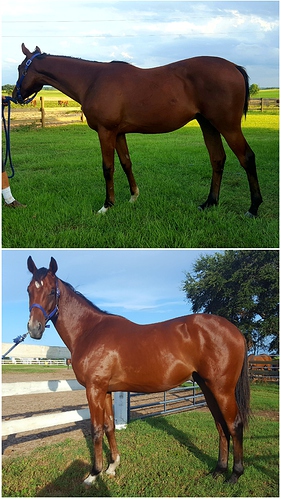[deleted]
- Worms
- Teeth.
The pot bellied appearance is most often caused by a high worm load and/or inability to fully digest long stem forage. Check teeth twice a year and float as needed so hay/grass can be fully chewed and nutrients absorbed.
IMO, the second horse may not have a belly but it looks thin, with a sharp topline, prominent withers and pointed hip. Both horses may benefit from a diet higher in protein, perhaps including more soft leafy legume hay (alfalfa or perennial peanut if you must).
I deal with the same problem with my horse. There are many things you can try but at the end of the day, my horse is and has always been more sensitive to certain hay than others. I got my hay tested and it is low in protein and high in lignin, which is the undigestible part of hay. While that might be fine for some horses, it makes her bloated and gassy, and gives her the hay belly look.
Things you can try anyways:
- worming
- supplemental protein (amino acids)
- a good probiotic
- a forage based diet (no commercial grain) to feel out possible sensitivities (soy, etc)
- a psyllium cleanse in case she is consuming sand/dirt
Check for sand!
From your description and the photo, the second horse sounds like it has a stressy case of ulcers.
Any horse will be “tucked up” if it is constantly moving in turnout. 2 hours of walking the fence will lose any belly. But that doesn’t mean it is “healthy.” I know you want your horse’s belly gone, but honestly your horse looks in a bit better condition than the other one. If you want your horse to look fitter, try adding 30-45 minutes of walking before or after your rides.
I am sales prepping yearling colts right now and 30 minutes a day of brisk walking does a lot to build condition on a horse. Top photo June 20, bottom photo Aug 6, after daily hand walking.
I don’t see any pictures??
I don’t have any info on the breed , size, build or what your horses are eating. I also have no idea about the quality of the feed they are getting and all that is important.
When a horse is extremely thin it can take a long time to see improvement. Some horses who have no health issues or worms can still have a bit larger belly and that is normal for them.
My daughter’s mare is a bit like that but she is 20 now and not being ridden this year and eating well. Her coat is slick and she has no ribs so that is a fitness issue and nothing else.
I hope you can repost the pictures.
I’ll add in two other options;
Gas or pregnant.
There’s always the possibility a mare is pregnant.
But otherwise, this time of year the grass can make horses kind of bloated and gassy. If, for instance, after 12h of stall time she looks less fat it’s probably that.
In addition to all the good feed and medical advice here, a horse will develop better ab muscles if they are working on a way that makes them lift the back and carry themselves. A horse slopping around on the forehand inverted will have a saggy back and belly. Lateral work in hand and ground poles helps.
Also mares who have had foals can have a mommy tummy (just like people) that takes a while to tighten up.
How old is the horse? Pot belly can also be a sign of Cushings, especially if early onset case.
She is a mare, and you have only had her since March.
I would definitely ask the vet to check if she is in foal.

